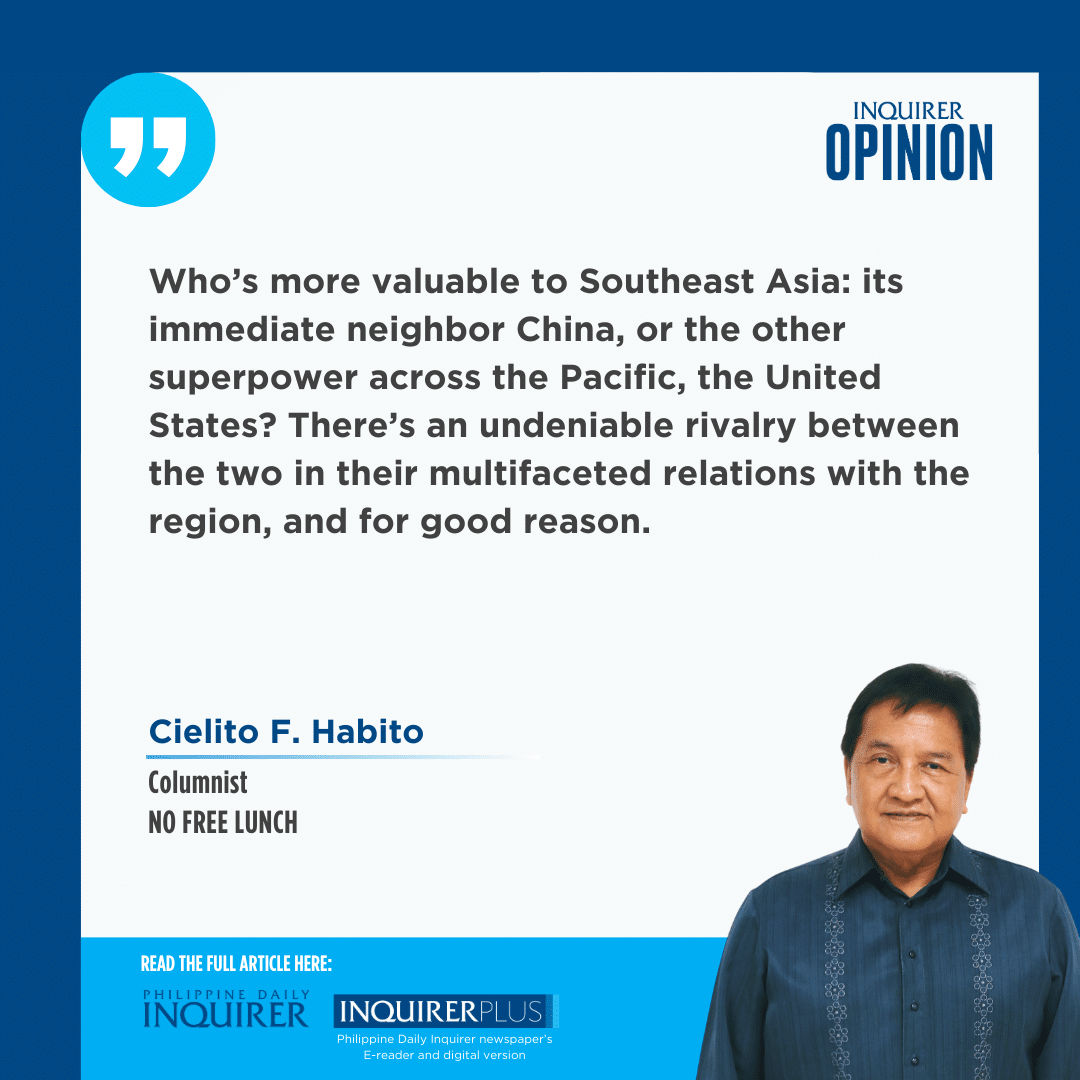Who’s more valuable to Southeast Asia: its immediate neighbor China, or the other superpower across the Pacific, the United States?
There’s an undeniable rivalry between the two in their multifaceted relations with the region, and for good reason. The Switzerland-based World Economic Forum describes Asean—the 10-member Association of Southeast Asian Nations—as the world’s “economic dark horse.” Its combined population of 685 million makes it the third-largest market in the world, next to India and China. It thus wields demographic power and is now acknowledged as a driver of the global economy.
The Asean countries share a common geography and ethnicities, but the economic disparities among them are wide. Average income in the richest member Singapore ($91,100 in 2023) is 77 times that in the poorest member Myanmar ($1,180). Price stability ranges from very stable (with Brunei’s and Thailand’s annual inflation rates of 0.4 and 1.2 percent, respectively) to hyperinflationary (Laos with 31.2 and Myanmar with 27.1 percent). The jobs situation ranges from virtual full employment in Cambodia and Thailand, with unemployment rates of 0.5 and 1.0 percent this year, to Indonesia’s 5.3 percent. Exports-to-GDP ratio ranges from dynamic Singapore’s 108.9 percent to inward-looking Philippines’ measly 12.7 percent (regional average is 55.9 percent). Education outcomes range from globally top-ranked Singapore to bottom-dwellers Philippines and Cambodia (77th and 81st, respectively) in the 2022 Programme for International Student Assessment or Pisa. With such wide disparities, it would be ideal if the US and China help the region with a “rising tide that lifts all boats” so that the wide inequalities both across and within countries in Asean could somehow be narrowed.
I was invited last week to a candid dialogue in Thailand on how China and the US are helping Southeast Asia. My assigned focus was on their economic contributions to the region. These come via trade, investment, economic assistance, tourism, labor migration, and more. I focused on the first three, which are the most prominent elements in the relationship, and for which data are readily available.
China is Asean’s largest trading partner, which is not surprising being right next door. Even so, the US actually took the lead from China early this year as the biggest buyer of Asean’s exports, even from the other side of the world. Trade balance with the US has consistently been in Asean’s favor, with a $200-billion trade surplus; that is, Asean sells more to the US than it buys from it, by that much. The reverse is true with China, which sells more to Asean than it buys, by about $100 billion, and this Asean trade deficit with China has grown tenfold since 2010, in an increasingly lopsided trade.
As to foreign direct investments, the US is Asean’s largest source, with $74.4 billion in FDI inflows in 2023. China comes in fourth with FDI flows of $17.3 billion, behind the European Union’s $24.9 billion and Asean cross-investments of $21.9 billion. American investments have been shifting to Asean since the US-China trade war and the COVID-19 pandemic led American manufacturers in China to shift out or add back-up factories in Asean, to the great benefit of the region.
China’s economic assistance comes mainly as soft loans for large infrastructure projects under the Belt and Road Initiative. In 2021, it pivoted to a Global Development Initiative promoting “people-centered, high-quality, green, and innovation-driven development.” The US Agency for International Development delivers a smaller but comprehensive package of grant assistance covering a wide range of areas including governance, education, health care, agriculture, manufacturing, renewable energy, digital economy, trade facilitation, and workforce development—all aimed to support economic growth, poverty reduction, and sustainable development in Asean. US grants and soft loans uphold labor and environmental standards, transparency, accountability, and human rights, which some see as intrusive conditionalities. While Chinese soft loan projects have no such “strings” attached, they provoke concerns about a lack of labor and environmental safeguards, looming “debt traps,” and the prospect of giving up state assets in the event of default. Their assistance with connectivity infrastructure is also feared to carry the risk of data security, cyber-espionage, and over-dependence.
There are pros and cons on each side. But rather than see it as a contest for the region, the dialogue agreed that complementation or even cooperation, rather than competition, would be in the best interest of Southeast Asia, and in turn, the world. However, current geopolitical realities make this little more than wishful thinking.
—————
cielito.habito@gmail.com
